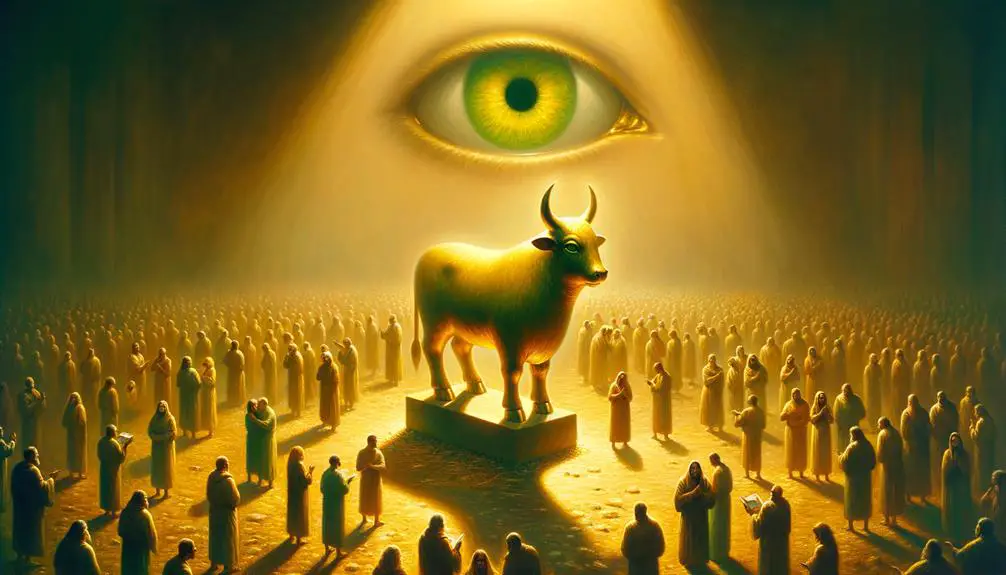Peek into the duality of yellow in the Bible, revealing layers of divine glory and human challenges, inviting deeper exploration.

Yellow in the Bible Means
In the tapestry of Biblical narratives, yellow weaves a complex thread of divine glory and human frailty. You'll find it painting scenes of opulence and divine presence, yet in the same breath, it whispers tales of illness and envy.
This duality invites you to explore deeper, to uncover how a single color carries such weight in sacred texts. What might seem like a mere detail opens doors to understanding broader themes of purity, judgment, and the very nature of God's interaction with humanity.
Isn't it intriguing how the nuances of yellow can illuminate such profound insights?
Key Takeaways
- Yellow symbolizes divine glory and God's presence, inviting reflection on His majesty.
- It represents wealth, both material and spiritual, emphasizing righteous living.
- Yellow indicates sickness but also healing, highlighting the link between physical wellness and spiritual health.
- The color signifies jealousy and envy, cautioning against their destructive impact in communities.
Symbol of Divine Glory

Throughout the Bible, yellow often symbolizes divine glory, serving as a vivid representation of God's presence and power in the lives of believers. This connection between yellow, specifically in the form of golden light, and heavenly radiance isn't merely a matter of aesthetics but deeply rooted in theological symbolism. The golden light represents an unapproachable light in which God dwells (1 Timothy 6:16), a concept that underlines the transcendence and otherness of the divine.
In the Old Testament, examples abound of yellow or gold as a symbol of God's glory. Notably, the construction of the Tabernacle, as detailed in Exodus, required extensive use of gold, a material that reflected God's glory to the Israelites. This use of gold in the Tabernacle serves as a physical manifestation of God's heavenly radiance, inviting the presence of the divine among His people. Similarly, in visions of the heavenly throne room, such as those found in Ezekiel 1:4-28 and Revelation 4:1-11, the imagery of gleaming, yellowish gold surrounds the presence of God, reinforcing the association of yellow with divine glory.
The symbolic use of yellow to denote divine glory invites believers to reflect on the majesty and holiness of God. It's a reminder that God's presence isn't just a comforting nearness but a powerful, transformative force characterized by overwhelming beauty and purity. Thus, when you encounter references to golden light or heavenly radiance in biblical text, you're being pointed toward the incomparable glory of God, a theme that not only elevates your understanding of divine attributes but also enriches your spiritual contemplation.
Representation of Wealth
In the biblical context, yellow, particularly in the form of gold, often signifies wealth, reflecting societal values and divine blessings on prosperity. This representation isn't arbitrary but deeply rooted in the cultural and historical backdrop of the biblical narratives. Golden treasures, frequently mentioned in scripture, serve not only as literal wealth but also as metaphors for spiritual richness and God's favor.
Take, for example, the detailed descriptions of Solomon's temple, adorned with gold (1 Kings 6:21-22), symbolizing not only Israel's material wealth but also its spiritual zenith under Solomon's reign. The presence of gold in this context underscores the prosperity symbolism, suggesting a divine endorsement of wealth when it's used righteously.
Moreover, in the New Testament, the gifts of the Magi, which included gold (Matthew 2:11), symbolize the recognition of Jesus' kingship, again linking gold with high status and divine favor. This act illustrates how golden treasures are emblematic of both earthly wealth and heavenly acknowledgment.
In analyzing these texts, it's crucial to recognize that the biblical endorsement of wealth, represented by gold, is nuanced. Prosperity is celebrated not for its own sake but as a testament to God's blessing and as a resource for righteous living and generosity. Thus, the biblical portrayal of yellow as wealth goes beyond material riches, encapsulating a broader, more spiritual dimension of prosperity.
Indicator of Sickness

You'll find that the Bible employs color symbolism extensively, with yellow often signaling sickness.
For instance, leprosy is depicted with yellow signs, illustrating not just physical ailment but also spiritual ramifications, as discussed by scholars like Klein (2004).
This color's association with illness invites a deeper understanding of its symbolic significance within biblical narratives.
Biblical Sickness Symbolism
Colors in the Bible often carry deep symbolic meanings, and yellow, in particular, serves as an indicator of sickness, reflecting the historical and cultural contexts of biblical times. This hue is intricately linked with disease metaphors and healing narratives, suggesting not only the presence of illness but also the societal and theological interpretations of disease.
Scholars suggest that yellow's association with sickness in the scriptures may point to the visible symptoms of certain diseases, which were prevalent in ancient times. Moreover, these references often come with underlying messages of purification, testing, and ultimately, divine intervention and healing. This symbolism emphasizes the transformative journey from illness to health, underpinning the belief in the power of faith and divine will to overcome physical ailments.
Leprosy and Yellow Signs
While exploring the symbolic dimensions of yellow in biblical texts, it's crucial to examine how leprosy, often signaled by yellowing of the skin, serves as a potent emblem of sickness and divine testing. This condition, deeply intertwined with cultural perceptions, highlights a broader narrative on purity and impurity within biblical lore.
The manifestations of skin conditions, particularly leprosy, aren't merely physical but carry significant symbolic weight:
- Manifestation of divine judgment
- Physical embodiment of spiritual malaise
- Test of communal ethics
- Signal for purification rituals
- Indicator of societal exclusion
These elements underscore the complex interplay between physical ailments and their broader spiritual and cultural implications. Understanding leprosy's representation in biblical texts provides insight into ancient perspectives on disease, community, and the divine.
Spiritual Implications of Illness
Throughout history, illness has often been interpreted as a manifestation of divine disfavor, serving as a critical indicator of both individual and communal spiritual health within biblical narratives. This perspective emphasizes the role of faith resilience in confronting diseases, where healing miracles are not just acts of physical restoration but profound demonstrations of spiritual renewal.
Healing Miracles |
Faith Resilience |
|---|---|
Physical restoration |
Spiritual renewal |
Divine intervention |
Inner strength |
Testament of faith |
Overcoming adversity |
In this light, the narratives surrounding illness and healing in biblical contexts underscore a dual pathway of recovery: one that is physical, through the miraculous acts of healing, and another that is spiritual, through the strengthening of faith resilience. The interplay between these elements highlights the comprehensive approach to wellness and spiritual health advocated in the scriptures.
Sign of Jealousy

You'll find that scholars, such as Frymer-Kensky (2006), have noted how yellow, within the biblical context, symbolizes jealousy, intertwining deeply with emotions and divine reactions.
This color's association with jealousy isn't merely superficial but rooted in complex theological and psychological underpinnings, offering a nuanced understanding of biblical narratives.
Biblical Jealousy Representation
In biblical texts, jealousy often manifests through vivid imagery and symbolic actions, reflecting its complex role in human relationships and divine interactions. The origins of jealousy, deeply rooted in human nature, intertwine with the consequences of envy, which are extensively documented throughout Scripture. This intricate connection highlights:
- Jealousy's fundamental ties to covetous desires
- The destructive path envy carves in communities
- God's perspective on jealousy as both a divine attribute and a human flaw
- The transformative potential of understanding jealousy's spiritual implications
- The necessity of confronting envy to foster relational and communal healing
Analyzing jealousy in the Bible reveals its dual nature, serving as a cautionary tale against the perils of unchecked envy and a reminder of the importance of self-awareness and spiritual growth.
Color Symbolism Analysis
Many biblical narratives employ color symbolism to convey deeper meanings, with certain hues often signaling complex emotions such as jealousy. Yellow, in particular, has been interpreted through various cultural perspectives as a sign of envy and deceit. Scholars suggest that this association might stem from the color's natural occurrences in decay and disease, which are traditionally viewed with suspicion and negativity.
Artistic interpretations, especially in medieval and Renaissance biblical art, further reinforced yellow's connection to jealousy by depicting betraying or envious characters in yellow attire. This choice of color not only highlights the character's emotional state but also serves as a visual cue for the audience, anchoring the biblical message within a rich tapestry of symbolism and cultural significance.
Connotations of Fire
Throughout biblical texts, fire often symbolizes both divine presence and judgment, reflecting a complex interplay between destruction and purification. You'll find that flame interpretations and ignition symbolism are richly layered, offering insights into God's character and the consequences of human actions. Fire's dual nature in scripture underscores its significance in divine communication and the transformative processes it symbolizes.
When exploring biblical fire, several key themes emerge:
- Divine Presence: Fire signifies God's presence, as seen in the burning bush encounter with Moses (Exodus 3:2-4). This moment highlights fire as a medium of divine revelation and guidance.
- Purification: Fire purifies, removing impurities to reveal what's genuine. In a spiritual context, this reflects the purification of believers' faith (1 Peter 1:7).
- Judgment: Fire also represents divine judgment, consuming what's deemed unworthy or sinful (2 Thessalonians 1:8).
- Holy Spirit: Pentecost introduces fire as a symbol for the Holy Spirit's presence and power within believers (Acts 2:3-4).
- Covenant and Sacrifice: Fire plays a role in covenant ceremonies and sacrifices, signifying God's acceptance of offerings (Genesis 15:17, Leviticus 9:24).
These themes demonstrate fire's multifaceted role in biblical narratives. Its capacity to signify God's nearness and to act as an agent of purification and judgment exemplifies the profound spiritual significance attributed to fire. Analyzing these interpretations helps you grasp the deeper meanings behind biblical references to fire, beyond mere physical combustion to spiritual and moral dimensions.
Reflections of Purity

Shifting focus to the theme of purity, the Bible frequently employs images of cleansing and refinement to symbolize the process of spiritual purification. This theme often manifests through references to golden garments and ceremonial attire, both of which serve as metaphors for purity and holiness. The color yellow, specifically in the form of gold, encapsulates this theme, representing not just wealth and royalty but also divine purity.
Golden garments, for instance, are not merely aesthetic or symbolic of status; they reflect a state of spiritual cleanliness and closeness to the divine. These garments, often mentioned in the context of high priests or sacred ceremonies, underscore the importance of purity in one's relationship with God.
Ceremonial attire, similarly, plays a crucial role in religious rites and practices. Such attire, meticulously described in passages concerning Levitical priests, is imbued with symbolism. Each piece, color, and material holds significance, with yellow or gold often denoting purity, divinity, and separation for a holy purpose.
To help you enjoy what is written, consider the following table:
Aspect |
Significance |
|---|---|
Golden Garments |
Symbolize spiritual cleanliness and divine purity. |
Ceremonial Attire |
Indicates separation for holiness and purity in service. |
This analysis reveals how the Bible uses visual and material symbols, like golden garments and ceremonial attire, to convey complex spiritual truths. These elements are not merely ornamental but are deeply intertwined with the biblical theme of purity, serving as a tangible reflection of one's spiritual state and relationship with the divine.
Elements of Judgment
In the Bible, yellow, particularly in the form of gold, isn't only a symbol of purity but also serves as a vivid emblem of judgment, illustrating how divine discernment separates the righteous from the unrighteous. This dual symbolism is deeply embedded in biblical narratives, where gold often signifies not just wealth and divinity but also the critical moments of judgment.
The story of the golden calf (Exodus 32) is a prime example. Here, gold, molded into an idol, becomes a test of faithfulness. God's judgment upon this act of idolatry underscores the theme that while gold symbolizes purity, its misuse can lead to divine judgment. This incident reflects how judgment in the Bible isn't merely punitive but serves to refine and define the boundaries of faith.
Harvest time, another significant symbol associated with yellow, further emphasizes judgment. The harvesting of crops, often depicted in golden hues, symbolizes the gathering of the righteous and the separation from the unrighteous at the end of age (Matthew 13:24-30). This imagery highlights:
- The inevitability of judgment
- The separation of true faith from falsehood
- The purification process through divine scrutiny
- The final gathering of the righteous
- The dispensation of justice according to one's deeds
These elements underscore the multifaceted nature of judgment in biblical texts. Judgment is portrayed not just as a future event but as an ongoing process, where individuals and communities are continually assessed against divine standards. The use of gold and harvest imagery enriches our understanding of biblical judgment, illustrating it as both a purifying force and a definitive separation based on righteousness.
Frequently Asked Questions
How Has the Interpretation of the Color Yellow in the Bible Evolved Over the Centuries, Especially With the Advent of Modern Biblical Scholarship?
You've noticed how the interpretation of the color yellow in biblical texts has shifted, especially with modern biblical scholarship. This change highlights the fluid nature of color symbolism and interpretative evolution over centuries.
Initially, yellow might've held different connotations, but scholars now examine these texts through various lenses, uncovering new meanings and contexts. This scholarly approach enriches our understanding, showing how interpretations evolve with cultural and academic advancements.
Are There Specific Biblical Figures or Events That Are Uniquely Associated With the Color Yellow, Beyond the General Thematic Elements Listed?
You might think that yellow doesn't play a significant role in the Bible, but it does. Specific figures or events tied to yellow are rare, yet yellow garments and leprosy descriptions stand out.
These elements aren't just colors or symptoms; they symbolize deeper themes like sin, healing, and divinity. Analyzing these mentions uncovers a complex interplay of symbolism, enriching our understanding of biblical narratives and the use of color to convey spiritual truths.
How Do Different Translations of the Bible Handle the Nuances of the Color Yellow, Particularly in Languages Where There Might Be Multiple Words for Shades of Yellow?
You'll find that different Bible translations tackle the nuances of yellow with varying degrees of precision, highlighting the challenges in color semantics.
This variance is particularly evident in languages with multiple words for shades of yellow. Translation challenges arise as translators strive to maintain the original's meaning while navigating the rich palette of target languages.
Scholarly analysis suggests these decisions can significantly affect interpretation, underscoring the complexity of biblical color symbolism.
In What Ways Have Contemporary Artists and Theologians Used the Symbolism of Yellow From the Bible in Modern Works or Interpretations?
You're navigating a sea where contemporary artists and theologians have anchored the biblical symbolism of yellow into modern creations.
In this realm, yellow fashion isn't just clothing; it's a canvas where tales of divinity and humanity intertwine.
Musical interpretations, on the other hand, strike chords that resonate with ancient texts, giving voice to a color that whispers of both caution and hope.
This synthesis of art and faith paints a vibrant picture of tradition meeting innovation.
Can the Symbolism of Yellow in the Bible Be Correlated With Similar Symbolism in Other Ancient Texts or Religions From the Same Period?
You're exploring how the symbolism of yellow, as depicted in ancient texts and religions, shares commonalities across cultures during the same period.
This inquiry delves into the ritual significance and portrayal of yellow in ancient textiles, suggesting a widespread cultural or theological resonance.
Conclusion
In the tapestry of biblical narratives, yellow weaves a complex pattern, shimmering with divine glory and reflecting the sheen of wealth. Yet, this hue also casts shadows of sickness and jealousy, igniting with the fire of divine presence.
Within its spectrum, yellow embodies purity and signals judgment, offering a multifaceted lens through which to interpret sacred texts. Through scholarly analysis, we discern how this color, far from monolithic, serves as a vibrant thread in the fabric of biblical symbolism.



Sign up